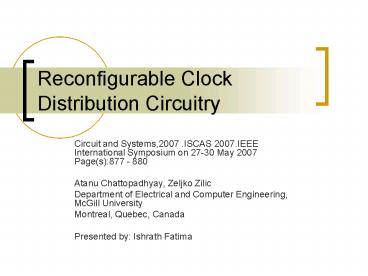Reconfigurable Clock Distribution Circuitry PowerPoint PPT Presentation
1 / 8
Title: Reconfigurable Clock Distribution Circuitry
1
Reconfigurable Clock Distribution Circuitry
- Circuit and Systems,2007 .ISCAS 2007.IEEE
International Symposium on 27-30 May 2007
Page(s)877 - 880 - Atanu Chattopadhyay, Zeljko Zilic
- Department of Electrical and Computer
Engineering, McGill University - Montreal, Quebec, Canada
- Presented by Ishrath Fatima
2
Features
- Skew ranges from 3.9-5.5ps for a 3-clock
domain/15-tap configuration. - Worst case skew under 4 for all frequencies.
- Power consumption of about 62.82mW
- No de-skewing method used.
- Frequency 1.9GHz
- Clock Period 525ps
- Reference-based scheme for skew compensation.
- Daisy chaining the clock to distribute clock
without distortion and reducing the clock load. - PLL replaced by delay lines, which reduces power
consumption. - Reconfigurable reprogrammable clock
distribution network.
3
Reference Based clock distribution
4
Reference Based clock distribution Architecture
5
Reference Based clock distribution scheme
- Device is sub-divided into multiple regions.
- H-Tree to distribute clock from tap to leaves.
- Bi-directional clock distribution line.
- Its scalable and compatible with irregularly
shaped distribution areas. - Clock distribution line has a constant delay K
over its entire length. - Phases Synchronization, Calibration and
operation. - Synchronization The forward clock is delayed to
align with reverse clock, which results in each
local clock to a position directly between
forward and reverse moving reference clocks,
results in skew free clocks at each tap. - Calibration Disable source delay element for an
appropriate average clockand align polarity of
local clocks by inverting appropriate taps. - Operation Unused circuitry disabled to save
power. - Each local delay line is required to save the
delay settings determined during synchronization. - Clock buffers allow us to re-direct clocks
dynamically at certain pre-defined switch points,
making distribution reconfigurable.
6
15-tap Reconfigurable Clock Distributions
7
References
- A. Chattopadhyay and Z. Zilic Reference-based
clock distribution architectures, Proc. MWSCAS
2006. - H. Lee, H. Q. Nguyen, and D. W. Potter, Design
self-synchronized clock distribution networks in
an SoC ASIC using DLL with remote clock
feedback, Proc ASICSOC 2000, 248-252
8
Questions??

